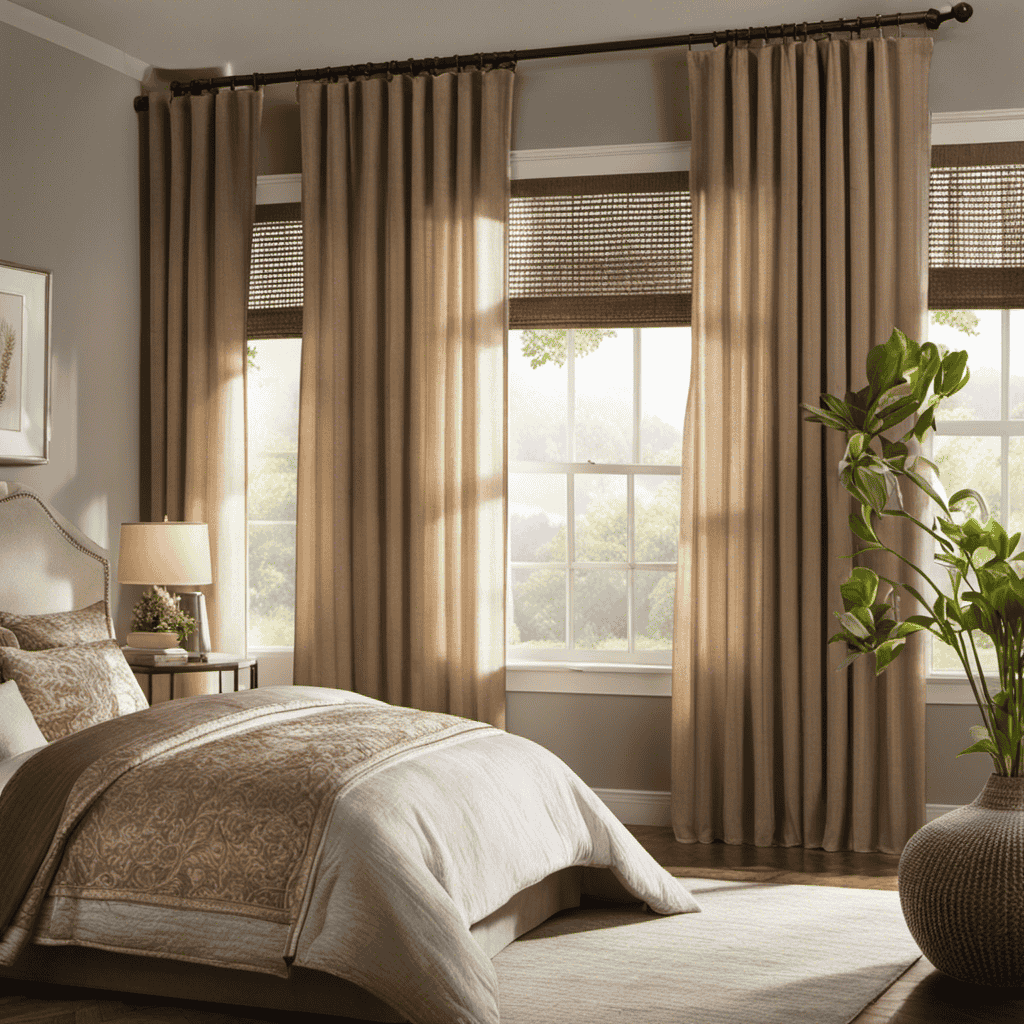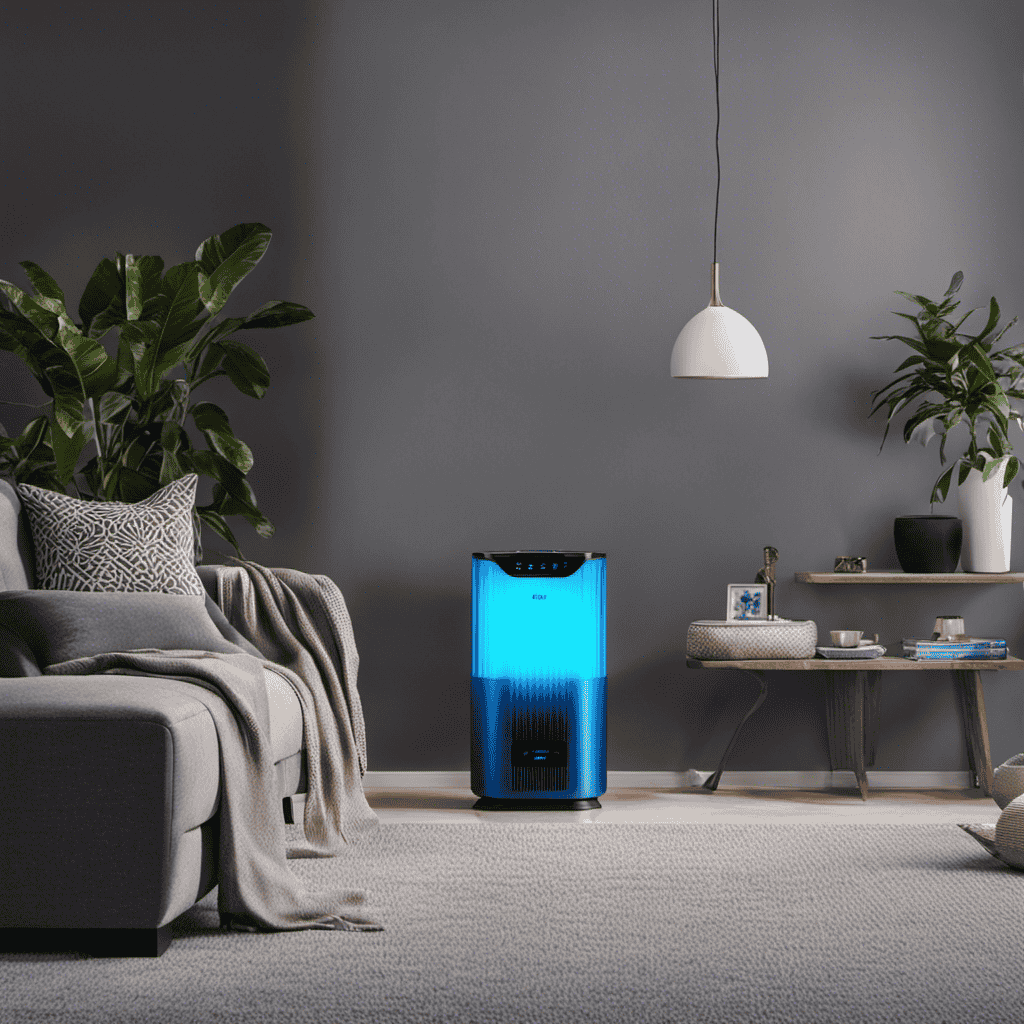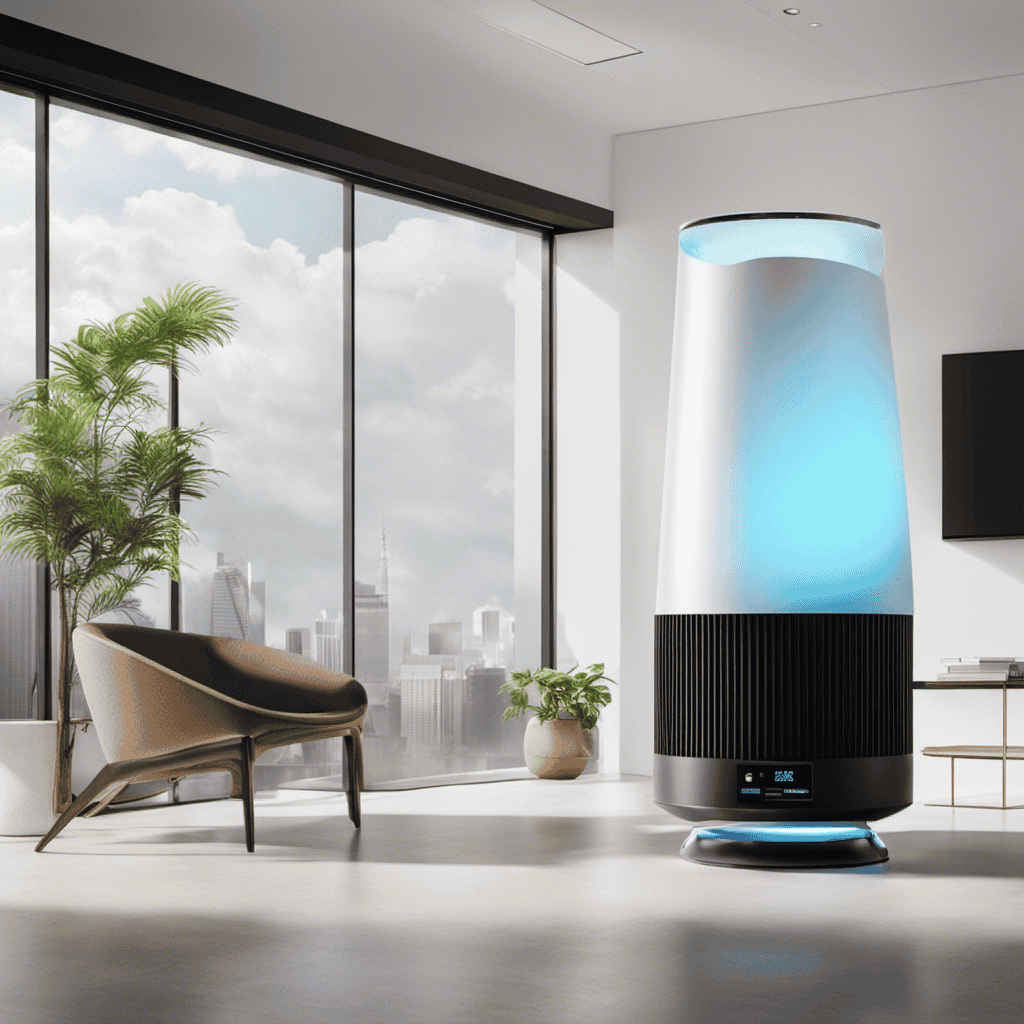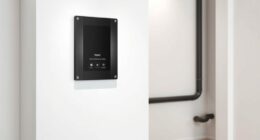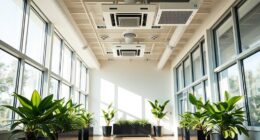Thanks to my reliable air purifier, I am able to breathe in fresher air.
But have you ever wondered what exactly these devices do? In this article, I’ll delve into the inner workings of air purifiers and explain how they eliminate various types of pollutants from our indoor environments.
We’ll also explore the numerous benefits of using an air purifier and discuss important factors to consider when choosing one.
So, let’s dive into the world of air purifiers and uncover their secrets.
Key Takeaways
- Air purifiers use filters to trap and remove pollutants from the air.
- HEPA filters are considered the gold standard, trapping up to 99.97% of particles.
- Activated carbon filters are used to remove odors and harmful gases.
- Regular maintenance and filter replacement are crucial for optimal performance.
How Do Air Purifiers Work
To understand how air purifiers work, you need to know that they use filters to trap and remove pollutants from the air. Air purifiers are designed using advanced technology that allows them to effectively clean the air in our homes or workplaces. These devices work by drawing in the surrounding air and passing it through a series of filters that are specifically designed to capture various types of pollutants.
The effectiveness of air purifiers is determined by the quality and efficiency of their filters. HEPA (High-Efficiency Particulate Air) filters are considered the gold standard in air purifier technology. These filters are capable of trapping up to 99.97% of particles as small as 0.3 microns, including dust, pollen, pet dander, and even some bacteria and viruses. Activated carbon filters are also commonly used to remove odors and harmful gases from the air.
Air purifiers can significantly improve indoor air quality by reducing allergens and pollutants that can trigger respiratory problems and allergies. However, it is important to note that air purifiers are not a cure-all solution. They are most effective when used in conjunction with other measures such as regular cleaning, proper ventilation, and minimizing the use of products that release pollutants into the air.
Types of Air Pollutants Filtered by Air Purifiers
Different types of pollutants, such as dust, pollen, and pet dander, are filtered by air purifiers. These devices play a crucial role in improving indoor air quality, which has significant health benefits. Air purifiers are designed to capture and remove various contaminants present in the air, ensuring a cleaner and healthier breathing environment.
Here are three key types of pollutants that air purifiers effectively filter:
-
Particulate Matter (PM): Airborne particles, including dust mites, pollen, and mold spores, can trigger allergies and respiratory issues. Air purifiers with HEPA filters can effectively trap these particles, reducing their presence in the air.
-
Volatile Organic Compounds (VOCs): These are harmful gases emitted by household products like cleaning agents, paints, and furniture. Air purifiers equipped with activated carbon filters can effectively absorb and neutralize VOCs, improving indoor air quality.
-
Pet Allergens: Pet dander, saliva, and urine can trigger allergic reactions in susceptible individuals. Air purifiers with HEPA filters can capture and remove these allergens, allowing pet owners to enjoy cleaner air while minimizing allergic reactions.
Benefits of Using an Air Purifier
Using an air purifier can greatly improve indoor air quality and provide numerous health benefits. Air purifiers are designed to remove harmful pollutants and allergens from the air, creating a healthier environment for you and your family. The effectiveness of an air purifier depends on the technology it uses and the size of the space it is meant to clean.
One of the most common technologies used in air purifiers is HEPA filtration. HEPA stands for High Efficiency Particulate Air and it is capable of capturing up to 99.97% of particles as small as 0.3 microns. This includes dust, pet dander, pollen, and even some bacteria and viruses. Another technology often found in air purifiers is activated carbon filtration, which helps to remove odors and harmful chemicals from the air.
To better understand the effectiveness of air purifiers, let’s take a look at the following table:
| Air Purifier Technology | Effectiveness |
|---|---|
| HEPA Filtration | High |
| Activated Carbon Filtration | Moderate |
| UV-C Light Technology | Moderate |
| Ionic Technology | Low |
| Electrostatic Precipitators | Low |
As you can see, different technologies have varying levels of effectiveness in removing pollutants from the air. It’s important to choose an air purifier that fits your specific needs and the size of your space. Additionally, regular maintenance and filter replacement are crucial for optimal performance.
Factors to Consider When Choosing an Air Purifier
When considering which air purifier to purchase, there are several essential features to keep in mind. These include the type of filtration system used, the size of the unit, and the noise level it produces.
Additionally, it’s important to choose an air purifier that’s suitable for your specific needs, whether that’s targeting allergies, eliminating odors, or reducing airborne particles.
Lastly, it’s crucial to consider the maintenance requirements and costs associated with the air purifier, such as filter replacements and electricity consumption.
Essential Features to Consider
One important feature to consider when choosing an air purifier is its ability to remove allergens from the air. This is crucial for individuals who suffer from allergies or asthma, as it helps create a clean and healthy indoor environment.
When looking at different air purifier brands, it is also important to consider their energy efficiency. Some air purifiers consume a lot of energy, which can lead to higher electricity bills.
To help you make an informed decision, here are three essential features to consider:
-
HEPA Filter: Look for air purifiers that are equipped with a high-efficiency particulate air (HEPA) filter. This filter is capable of capturing tiny particles, including allergens, dust, and pet dander.
-
Activated Carbon Filter: An activated carbon filter helps remove odors, chemicals, and volatile organic compounds (VOCs) from the air. It is especially beneficial for those who live in areas with high pollution levels.
-
Air Change Rate: The air change rate refers to how many times the air purifier can filter the entire room’s volume in one hour. Higher air change rates are generally more effective at removing allergens and pollutants.
Considering these features will help you find an air purifier that is not only effective in removing allergens but also energy-efficient. Such a purifier will be suitable for your specific needs, ensuring a clean and healthy indoor environment.
Suitable for Specific Needs
Now that we have discussed the essential features to consider when choosing an air purifier, let’s delve into the topic of finding the right air purifier for specific needs. Different air purifiers are designed to target specific pollutants and cater to different environments. To help you understand which air purifier suits your needs best, I have prepared a table that highlights the specific air purifiers and their corresponding benefits:
| Specific Air Purifiers | Benefits |
|---|---|
| HEPA Filters | Traps small particles like pollen, dust, and pet dander |
| Carbon Filters | Removes odors and harmful gases |
| UV-C Light Purifiers | Kills bacteria, viruses, and mold spores |
| Ionizers | Removes particles from the air by charging them |
| Activated Carbon Filters | Eliminates volatile organic compounds (VOCs) |
Maintenance Requirements and Costs
To keep your chosen air purifier running smoothly and efficiently, it’s important to regularly clean or replace the filters and follow the manufacturer’s recommended maintenance schedule. Maintaining your air purifier is crucial to ensure that it continues to effectively remove pollutants from the air in your home.
Here are some key points to consider:
-
Clean or replace filters: Filters are the backbone of any air purifier and they capture airborne particles. Over time, filters can become clogged with dust, dirt, and other pollutants, reducing their effectiveness. Regularly cleaning or replacing filters is essential to maintain optimal performance.
-
Follow the maintenance schedule: Manufacturers provide specific guidelines for maintenance, including filter replacement intervals. Adhering to the recommended maintenance schedule will help prolong the lifespan of your air purifier and ensure its continued efficiency.
-
Consider the costs: It’s important to factor in the cost of filter replacement when purchasing an air purifier. Some filters require more frequent replacement than others, so it’s wise to research and estimate the ongoing costs associated with maintaining your chosen air purifier.
How to Maintain and Clean an Air Purifier
Regularly cleaning and maintaining your air purifier is essential for ensuring its optimal performance. Neglecting maintenance can lead to a decrease in efficiency and even potential health risks. One of the most important aspects of maintenance is replacing the air purifier filter when necessary. Signs you need to replace your air purifier filter include a noticeable decrease in air quality, a decrease in airflow, or a strong odor coming from the unit.
To clean your air purifier, it is important to follow the manufacturer’s guidelines. Start by turning off and unplugging the unit. Remove the filter and gently vacuum it to remove any loose debris. If the filter is washable, rinse it with lukewarm water and mild soap, making sure to thoroughly rinse and air dry before reinstalling. For non-washable filters, replace them according to the manufacturer’s recommendations.
In addition to regular filter maintenance, it is crucial to clean the exterior of the air purifier. Use a soft, damp cloth to wipe down the unit, making sure to remove any dust or dirt that has accumulated. Pay extra attention to the vents and grilles, as these can become clogged and hinder airflow.
Common Misconceptions About Air Purifiers
If you’re considering purchasing an air purifier, it’s important to be aware of common misconceptions and understand how they can affect your expectations. There are several myths about air purifiers that can often lead to misunderstandings about their effectiveness. Let’s debunk some of these myths:
-
Myth 1: Air purifiers eliminate all pollutants: While air purifiers are effective at removing many airborne particles such as dust, pollen, and pet dander, they cannot eliminate all pollutants. They may not be able to capture gases, odors, or certain chemicals.
-
Myth 2: Air purifiers can cure allergies: While air purifiers can help reduce allergens in the air, they cannot cure allergies. Allergies are caused by a reaction to specific substances, and air purifiers can only help alleviate symptoms by removing the allergens from the air.
-
Myth 3: Air purifiers require no maintenance: Air purifiers do require regular maintenance to ensure optimal performance. Filters need to be replaced or cleaned regularly to maintain their effectiveness.
Understanding these common misconceptions will help you set realistic expectations for your air purifier. While they can be a valuable addition to your indoor environment, it’s important to remember that they have limitations and may not completely eliminate all pollutants or cure allergies.
Frequently Asked Questions
Can an Air Purifier Remove All Types of Pollutants From the Air?
Yes, an air purifier can effectively remove a wide range of pollutants from the air.
By utilizing advanced technology, such as HEPA filters, activated carbon filters, and UV-C light, air purifiers can capture and eliminate various types of pollutants.
These pollutants include dust, pollen, pet dander, mold spores, smoke particles, and even certain bacteria and viruses.
These air purifier benefits make them an essential tool in improving indoor air quality and maintaining a healthier living environment.
Are Air Purifiers Effective in Reducing Allergens Like Pollen and Pet Dander?
Air purifiers are highly effective in reducing allergens such as pollen and pet dander. They work by filtering the air and capturing these particles, preventing them from circulating in the indoor environment.
This is particularly beneficial for individuals with allergies and asthma, as it helps to alleviate symptoms and improve overall air quality. By removing these allergens, air purifiers create a cleaner and healthier living space, allowing individuals to breathe easier and enjoy a more comfortable environment.
How Often Should I Replace the Filters in My Air Purifier?
When it comes to air purifier maintenance, one important aspect is knowing when to replace the filters. Regularly replacing the filters is crucial for the optimal performance of your air purifier.
Signs of a dirty air filter include reduced airflow, increased dust accumulation, and a decrease in overall air quality.
To ensure that your air purifier functions effectively, it is recommended to replace the filters every 3-6 months, or as per the manufacturer’s guidelines.
Can Air Purifiers Help With the Smell of Cigarette Smoke or Other Strong Odors?
Air purifiers are highly effective in removing cooking odors, cigarette smoke, and strong pet odors. They work by using various filtration technologies to capture and eliminate these unwanted smells from the air.
By trapping airborne particles and neutralizing odor-causing molecules, air purifiers can significantly improve indoor air quality and create a fresh and clean environment.
Investing in a quality air purifier is a wise choice for anyone looking to eliminate strong odors and enjoy a healthier living space.
Can Air Purifiers Prevent the Spread of Airborne Viruses and Bacteria?
Air purifiers are incredibly beneficial in preventing the spread of airborne viruses and bacteria. They utilize advanced technology to filter out harmful particles and pathogens present in the air, ensuring a cleaner and healthier environment.
By capturing and eliminating these microorganisms, air purifiers help reduce the risk of respiratory infections and other illnesses caused by airborne contaminants.
Their effectiveness in purifying the air makes them an essential tool in maintaining indoor air quality and promoting overall well-being.
Conclusion
In conclusion, air purifiers are an essential tool in maintaining clean and healthy indoor air. They effectively remove various types of air pollutants through advanced filtration systems. This ensures that we breathe in fresh and pure air. The benefits of using an air purifier are numerous. They can reduce allergies and asthma symptoms and improve overall air quality.
When choosing an air purifier, it is crucial to consider factors such as room size and specific filtration needs. Regular maintenance and cleaning are also vital to ensure optimal performance.
Don’t let misconceptions cloud your judgment. Invest in an air purifier and breathe easier today.



